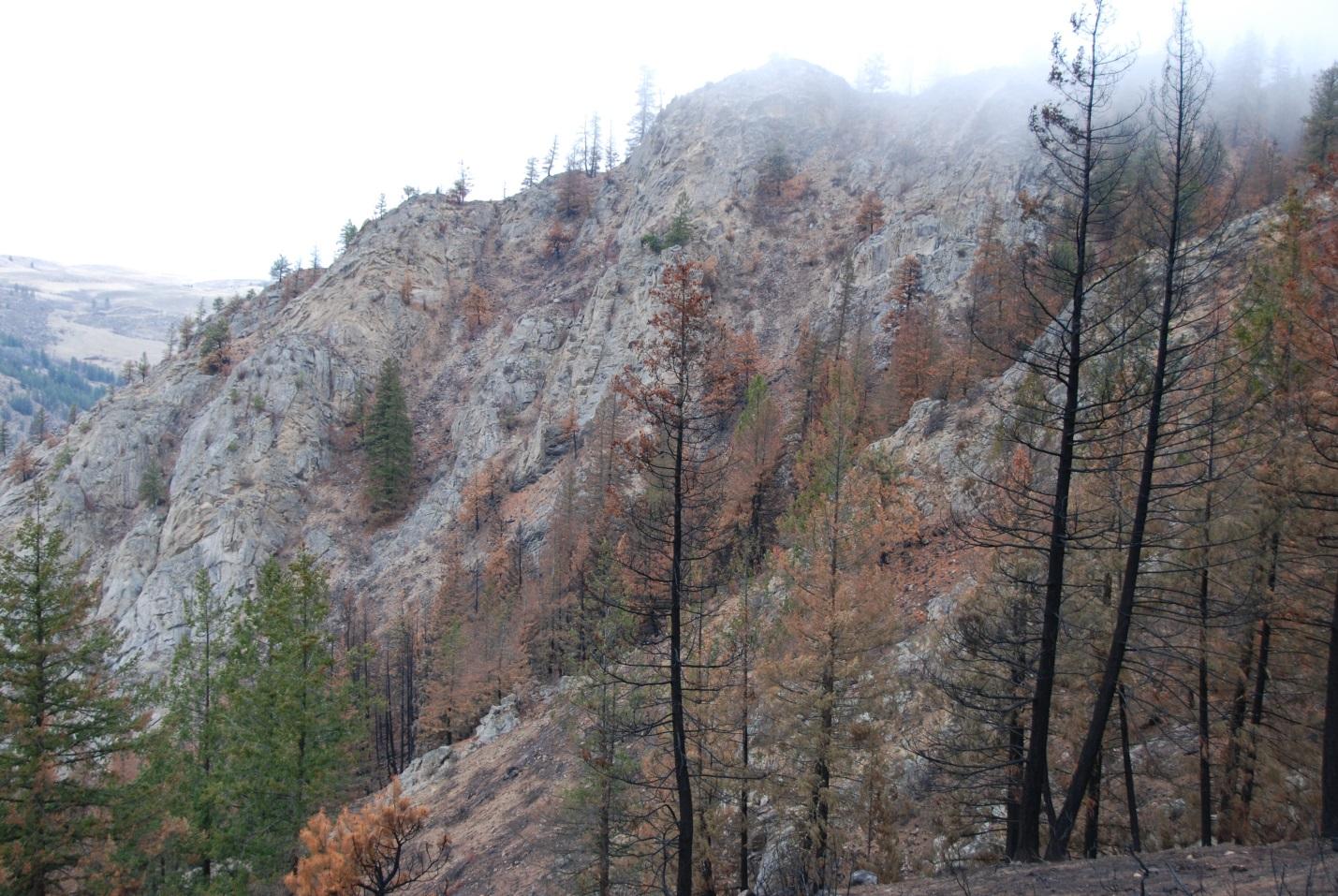
The Pogue Mountain offers a variety of recreational opportunities across. Green Lake offers camping and fishing adjacent to this unit. Among recreation activities enjoyed on the unit is hunting, pack-in style camping, hiking, biking, and horseback riding. The unit itself is managed as mule deer winter range. The mountainous property is predominately shrubsteppe and scattered conifers, with tall stands of mature big sagebrush along the lower elevations where there are historical accounts of Columbian sharp-tailed grouse use.
The Pogue Mountain Unit is located 4 miles northwest of Omak and west of the Conconully Highway in Okanogan County. The unit can be accessed from Green Lake Road on the west side of the unit, and the Green Lake Campground.
The Pogue Mountain Unit occurs in the Okanogan River Watershed. Surrounding land is a mix of public (U.S. Bureau of Land Management) and private ownership; these lands are managed primarily for livestock grazing.
This unit is part of the Scotch Creek Wildlife Area.
Game Management Unit: 233
Getting there
Maps and directions to WDFW-managed access points for this unit. Opens Google Maps in a new tab.
Recreation and public access
A Discover Pass is required on WDFW lands -- including water access areas, wildlife areas, and campgrounds -- unless you already have a Vehicle Access Pass issued with the purchase of an eligible hunting or fishing license. Recreate responsibly on public lands: please know the Public Conduct Rules.
Public facility information:
- Parking, restrooms, campground, and boat launch nearby at the Green Lake water access site.
Recreation and access advisories
- Motorized recreation activities are prohibited.
- Public access from other areas is difficult as roads leading to the property cross private lands. Visitors should seek permission from private landowners.
- The unit can be accessed from the Green Lake water access site. Terrain from this direction is rocky and steep, and not recommended for visitors in poor physical condition or horses.
Hunting
Opportunities for hunting game animals include mule deer, white-tailed deer, quail, dusky and ruffed grouse, black bear, cougar, and bobcat.
Fishing
The Green Lake water access site provides boat access to Green Lake for winter trout fishing.
Wildlife viewing
This unit is mostly shrubsteppe with scattered conifers and big sagebrush in lower elevations, offering opportunities to view black bear, bobcat, cougar, mule and white-tailed deer, eagle, dusky and ruffed grouse, and quail.
During the winter, view deer roaming the hills and hawks soaring high above in the sky. In the spring, hear and see numerous songbirds. Columbian sharp-tailed have historically used the lower elevations.
Search for potential birding opportunities on or near a wildlife area unit by using eBird Northwest, a citizen science database portal that provides freely-shared bird lists at 'hotspots' and interactive maps plus other birding information updated daily.
Other recreational opportunities
This unit offers opportunities for hiking, biking, and horseback riding; while there are no developed trail systems on the Pogue Mountain Unit, numerous logging roads traversing this unit can be used as trails.
The campground east of the Green Lake water access location offers hiking access to the more remote and rugged areas of Pogue Mountain.
Conservation
This mountainous unit is predominately shrubsteppe and scattered conifers, with tall stands of mature big sagebrush along the lower elevations. The area was used primarily for cattle grazing and timber harvest as part of the Metcalf Ranch operation prior to WDFW purchase in 1991.
Special habitats and species
The unit is managed as mule deer winter range, but there are historical accounts of Greater sharp-tailed grouse use on the lower elevations.
Conservation goals
- Implement the Forest Management Plan which identifies current forest habitats, conditions, and future management needs
- See WDFW's Forest Health Story Map for more information about work happening on the unit.
- Improve the distribution and abundance of western gray squirrel populations
The unit is managed as mule deer winter range, but there are historical accounts of Greater sharp-tailed grouse use on the lower elevations.
- Implement the Forest Management Plan which identifies current forest habitats, conditions, and future management needs
- See WDFW's Forest Health Story Map for more information about work happening on the unit.
- Improve the distribution and abundance of western gray squirrel populations
Land stewardship
The Pogue Mountain Unit was purchased to conserve mule deer winter range.
Acquisition history
The parcels making up this area were purchased between 1954 and 1991.
| Funder | Fund |
|---|---|
| US Fish and Wildlife Service | Dingell-Johnson Sport Fish Restoration Program |
| US National Park Service | Land and Water Conservation Fund |
| WA Dept of Fish and Wildlife | WDFW Game Fund (now Wildlife Fund) |
| WA Recreation and Conservation Office | State Bond Account |
| WA Recreation and Conservation Office | Washington Wildlife and Recreation Program |
Management planning
2017 Scotch Creek and Sinlahekin Wildlife Areas Management Plan
In 2017, the Washington Department of Fish and Wildlife updated the management plan for the Scotch Creek Wildlife Area, which encompasses 23, 980 acres in Okanogan County, and the nearby Sinlahekin Wildlife Area in north central Washington. The plan, called the Scotch Creek & Sinlahekin Wildlife Area Management Plan, addresses the status of wildlife species and their habitat, ongoing restoration efforts and public recreation opportunities at both Scotch Creek and Sinlahekin wildlife areas. Every eight to 10 years, WDFW revises management plans for each of its 33 wildlife areas to document current conditions, address new agency initiatives, and identify new management priorities and actions. In between those major revisions, WDFW updates plans every two years to outline short-term objectives and accomplishments.
Planning Advisory Committee
Okanogan Valley Wildlife Area Advisory Committee